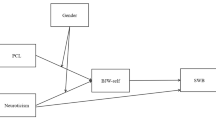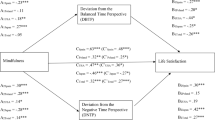Abstract
Cultural norm conformity shapes the structure of societies and accounts for group differences in the psychological functioning of individuals across cultures. This study investigated the moderating role of cultural tightness–looseness in the relationship between well-being orientations and time perspective dimensions. Participants (N = 744) from Kenya and Ghana completed the Zimbardo Time Perspective Inventory, Cultural Tightness–Looseness (CTL) scale, and the Hedonic Eudaimonic Motives of Action (HEMA) measure. Structural equation modelling analyses were conducted in Mplus. Data confirmed HEMA’s two-factor model, distinguishing hedonia and eudaimonia. Latent class analysis produced four theoretically plausible CTL latent classes indicating the participants’ experience of norm prescription and regulation of their societies. These CTL classes accounted for group differences in the levels of well-being motives, and time perspective. However, these classes only accounted for some of the variations in the relationships between hedonic and eudaimonic orientations and time perspective dimensions. Future research should further explore the role of eudaimonic orientation in facilitating a balanced time perspective, as well as the nature and function of cultural tightness in African societies.



Similar content being viewed by others
References
Anagnostopoulos, F., & Griva, F. (2012). Exploring time perspective in Greek young adults: Validation of the Zimbardo time perspective inventory and relationships with mental health indicators. Social Indicators Research,106, 41–59.
Boniwell, I., Osin, E., Linley, P. A., & Ivanchenko, G. V. (2010). A question of balance: Time perspective and well-being in British and Russian samples. The Journal of Positive Psychology,5(1), 24–40.
Boniwell, I., & Zimbardo, P. G. (2004). Balancing one’s time perspective in pursuit optimal functioning. In P. A. Linley & S. Joseph (Eds.), Positive psychology in practice (pp. 165–179). Hoboken NJ: Wiley.
Braitman, A. L., & Henson, J. M. (2015). The impact of time perspective latent profiles on college drinking: A multidimensional approach. Substance Use and Misuse,50, 664–673.
Bujacz, A., Vitterso, J., Huta, V., & Kaczmarek, L. D. (2014). Measuring hedonia and eudaimonia as motives for activities: Cross-national investigation through traditional and Bayesian structural equation modeling. Frontiers in Psychology,5, 1–10.
Byrne, B. M. (2012). Structural equation modeling with mplus: Basic concepts, applications, and programming. New York: Routledge.
Byrne, B. M., & Van de Vijver, F. J. (2010). Testing for measurement and structural equivalence in large-scale cross-cultural studies: Addressing the issue of nonequivalence. International Journal of Testing,10(2), 107–132.
Cheung, G. W., & Rensvold, R. B. (2002). Evaluating goodness-of-fit indexes for testing measurement invariance. Structural Equation Modeling,9(2), 233–255.
Christopher, J. C., Wendt, D. C., Maracek, J. M., & Goodman, D. M. (2014). Critical cultural awareness: Contributions to a globalizing psychology. American Psychologist,69(7), 645–655.
Cohen, A. B. (2009). Many forms of culture. American Psychologist,64(3), 194–204.
Diener, E. (2000). Subjective well-being: The science of happiness and a proposal for a national index. American Psychologist,55, 34–43.
Distefano, C., Zhu, M., & Mindrila, D. (2009). Understanding and using factor scores: Considerations for the applied researcher. Practical Assessment, Research & Evaluation,14(20), 1–11.
Drake, L., Duncan, E., Sutherland, F., Abernethy, C., & Henry, C. (2008). Time perspective and correlates of wellbeing. Time & Society,17(1), 47–61.
Eid, M., Langeheine, R., & Diener, E. (2003). Comparing typological structures across cultures by multigroup latent class analysis. Journal of Cross-Cultural Psychology,34(2), 195–210.
Ekselius, J. (2011). Namibian students’ time perspective: Investigating TP comparing ZTPI scores and conducting focus groups (Unpublished thesis). Linkoping University, Linkoping, Sweeden.
Field, A. (2013). Discovering statistics using SPSS (4th ed.). Los Angeles: Sage.
Ford, B. Q., Dmitrieva, J. O., Heller, D., Chentsova-Dutton, Y., Grossmann, I., Tamir, M., et al. (2015). Culture shapes whether the pursuit of happiness predicts higher or lower well-being. Journal of Experimental Psychology,144(6), 1053–1062.
Galinha, I. C., Garcia-Martin, M. A., Gomes, C., & Oishi, S. (2016). Criteria for happiness among people living in extreme poverty in Maputo, Mozambique. International Perspectives in Psychology: Research, Practice, Consultation,5(2), 67–90.
Geiser, C. (2013). Data analysis with Mplus. New York: Guilford Press.
Gelfand, M. J. (2012). Culture’s constraints: International differences in the strengths of social norms. Current Directions in Psychological Science,21(6), 420–424.
Gelfand, M. J., & Kashima, Y. (2016). Editorial overview: Culture—Advances in the science of culture and psychology. Current Opinion in Psychology,8, 9–10.
Gelfand, M. J., Nishii, L. H., & Raver, J. L. (2007). On the nature and importance of cultural tightness-looseness (CAHRS Working Paper #07-05). Ithaca, NY: Cornell University, School of Industrial and Labor Relations, Center for Advanced Human Resource Studies.
Gelfand, M. J., Raver, J. L., Nishini, L., Leslie, L. M., Jun, J., & Yamaguchi, S. (2011). Differences between tight and loose cultures: A 33-nation study. Science,332, 1100–1104.
Guell, P., Orchard, M., Yopo, M., & Jimenz-Molina, A. (2015). Time perspectives and subjective wellbeing in Chile. Social Indicators Research,123, 127–141.
Guignard, S., Apostolidis, T., & Demarque, C. (2014). Discussing normative features of future time perspective construct: Renewing with Lewinian approach from a sociocognitive perspective. New Ideas in Psychology,35, 1–10.
Harrington, J. R., & Gelfand, M. J. (2014). Tightness–looseness across 50 united states. PNAS,111(22), 7990–7995.
Henderson, L. W., Knight, T., & Richardson, B. (2013). An exploration of the well-being benefits of hedonic and eudaimonic behaviour. The Journal of Positive Psychology,8(4), 322–336.
Holman, E. A., & Zimbardo, P. G. (2009). The social language of time: The time perspective–social network connection. Basic and Applied Social Psychology,31(2), 136–147.
Hu, L. T., & Bentler, P. M. (1999). Cutoff criteria for fit indixes in covariance structure analysis: Conventional criteria versus new alternatives. Structural Equation Modeling,6, 1–55.
Huta, V. (2012). Linking people’s pursuits of eudaimonia and hedonia with characteristics of their parents: Parenting styles, verbally endorsed values, and role modelling. Journal of Happiness Studies,13, 47–61.
Huta, V. (2016). Eudaimonic and hedonic orientations: Theoretical considerations and research findings. In J. Vittersø (Ed.), Handbook of eudaimonic well-being. International handbooks of quality-of-life. Cham: Springer.
Huta, V., & Ryan, R. M. (2010). Pursuing pleasure or virtue: The differential and overlapping well-being benefits of hedonic and eudaimonic motives. Journal of Happiness Studies,11, 735–762.
Huta, V., & Waterman, A. (2014). Eudaimonia and its distinction from hedonia: Developing a classification and terminology for understanding conceptual and operational definitions. Journal of Happiness Studies,15, 1425–1456.
Joshanloo, M., Wissing, M. P., Khumalo, I. P., & Lamers, S. M. A. (2013). Measurement invariance of the Mental Health Continuum-Short Form (MHC-SF) across three cultural groups. Journal of Personality and Individual Differences,55, 755–759. https://doi.org/10.1016/j.paid.2013.06.002.
Kashdan, T. B., Biswas-Diener, R., & King, L. A. (2008). Reconsidering happiness: The costs of distinguishing between hedonics and eudaimonia. Journal of Positive Psychology,3, 219–233.
Kashima, Y. (2016). Culture and psychology in the 21st century: Conceptions of culture and person for psychology revisited. Journal of Cross-Cultural Psychology,47(1), 4–20.
Kim, O.-S., & Geistfeld, L. V. (2007). A comparative study of personal time perspective differences between Korean and American college students. Journal of Studies in International Education,11(2), 227–238.
Kline, R. B. (2011). Principles and practice of structural equation modeling (3rd ed.). New York: The Guilford Press.
Kostal, J., Klicperova-Baker, M., Lukavska, K., & Lukavsky, J. (2016). Short version of the Zimbardo time perspective inventory (ZTPI-short) with and without the future-negative scale, verified on nationally representative samples. Time & Society,25(2), 169–192.
Leech, N. L., Barrett, K. C., & Morgan, G. A. (2008). SPSS for intermediate statistics: Use and interpretation (3rd ed.). Mahwah: Lawrence Erlbaum Associates.
Ling, Y., Huebner, E. S., Fu, P., Zeng, Y., & He, Y. (2016). A person-oriented analysis of hope in Chinese adolescents. Personality and Individual Differences,101, 446–450.
Maslowsky, J., Jager, J., & Hemken, D. (2015). Estimating and interpreting latent variable interactions: A tutorial for applying the latent moderated structural equations method. International Journal of Behavioral Development,39(1), 87–96.
Mathews, G. (2012). Happiness, culture, and context. International Journal of Wellbeing,2(4), 299–312.
McNeish, D. (2017). Thanks coefficient alpha, We’ll take it from here. Psychological Methods. https://doi.org/10.1037/met0000144.
Milfont, T., Andrade, P., Belo, R., & Pessoa, V. (2008). Testing Zimbardo time perspective inventory in a Brazilian sample. Interamerican Journal of Psychology,42(1), 49–58.
Muthén, L. K., & Muthén, B. O. (1998–2017). Mplus statistical analysis with latent variables: Users’ guide (8th edn.). Los Angeles: Muthén & Muthén.
Nylund, K. L., Asparouhov, T., & Muthen, B. O. (2007). Deciding on the number of classes in latent class analysis and growth. Structural Equation Modeling,14(4), 535–569.
Pallant, J. (2011). SPSS survival manual: A step by step guide to data analysis using SPSS for Windows (4th ed.). Berkshire: McGraw Hill Open University Press.
Park, N., Peterson, C., & Ruch, W. (2009). Orientations to happiness and life satisfaction in twenty-seven nations. The Journal of Positive Psychology,4(4), 273–279.
Peterson, C., Park, N., & Seligman, M. E. P. (2005). Orientations to happiness and life satisfaction: The full life versus the empty life. Journal of Happiness Studies,6, 25–41.
Raykov, T. (2004). Behavioral scale reliability and measurement invariance evaluation using latent variable modelling. Behavior Therapy,35, 299–331.
Raykov, T. (2009). Evaluation of scale reliability for unidimensional measures using latent variable modeling. Measurement and Evaluation in Counseling and Development,42(3), 223–232.
Ryan, R. M., & Deci, E. L. (2001). On happiness and human potential: A review of research on hedonic and eudaimonic well-being. Annual Review of Psychology,52, 141–166.
Seginer, R. (2003). Adolescent future orientation: An integrated cultural and ecological perspective. Online Readings in Psychology and Culture, 6(1). https://doi.org/10.9707/2307-0919.1056.
Sircova, A., Van de Vijver, F. J. R., Osin, E., Milfont, T. L., Fieulaine, N., & Boyd, J. N. (2014). A global look at time: 24-country study of the equivalence of the Zimbardo time perspective inventory. SAGE Open,4(1), 1–12. https://doi.org/10.1177/2158244013515686.
Steger, M. F., Kashdan, T. B., & Oishi, S. (2008). Being good by doing good: Daily eudaimonic activity and well-being. Journal of Research in Personality,42, 22–42.
Stolarski, M., Vowinckel, J., Jankowski, K. S., & Zajenkowski, M. (2016). Mind the balance, be contented: Balanced time perspective mediates the relationship between mindfulness and life satisfaction. Personality and Individual Differences,93, 27–31.
Strasheim, A. (2014). Testing main and interaction effects in structural equation models with a categorical moderator variable. Management Dynamics,23(4), 31–68.
Triandis, H. C., & Gelfand, M. J. (1998). Converging measurement of horizontal and vertical individualism and collectivism. Journal of Personality and Social Psychology,74(1), 118–128.
Tseferidi, S.-I., Griva, F., & Anagnostopoulous, F. (2017). Time to get happy: Associations of time perspective with indicators of well-being. Psychology, Health, & Medicine,22(5), 618–624.
Uz, I. (2015). The index of cultural tightness and looseness among 68 countries. Journal of Cross-Cultural Psychology,46(30), 319–335.
Van de Schoot, R., Lugtig, P., & Hox, J. (2012). A checklist for testing measurement invariance. European Journal of Development Psychology,9(4), 486–492.
Waterman, A. S. (2008). Reconsidering happiness: A eudaimonist’s perspective. Journal of Positive Psychology,3(4), 234–252.
Waterman, A. S. (2013). The best within us: Positive psychology perspectives on eudaimonia. Washington: American Psychological Association. https://doi.org/10.1037/14092-000.
Wiesman, U., Ballas, I., & Hannich, H.-J. (2018). Sense of coherence, time perspective and positive aging. Journal of Happiness Studies,19, 817–839.
Zhang, J. W., Howell, R. T., & Stolarski, M. (2013). Comparing three methods to measure a balanced time perspective: The relationship between a balanced time perspective and subjective well-being. Journal of Happiness Studies,14, 169–184.
Zimbardo, P. G., & Boyd, N. J. (1999). Putting time in perspective: A valid, reliable individual-differences metric. Journal of Personality and Social Psychology,77(6), 1271–1288.
Author information
Authors and Affiliations
Corresponding author
Additional information
Publisher's Note
Springer Nature remains neutral with regard to jurisdictional claims in published maps and institutional affiliations.
Rights and permissions
About this article
Cite this article
Khumalo, I.P., Wilson-Fadiji, A. & Brouwers, S.A. Well-Being Orientations and Time Perspective Across Cultural Tightness–Looseness Latent Classes in Africa. J Happiness Stud 21, 1681–1703 (2020). https://doi.org/10.1007/s10902-019-00151-5
Published:
Issue Date:
DOI: https://doi.org/10.1007/s10902-019-00151-5




